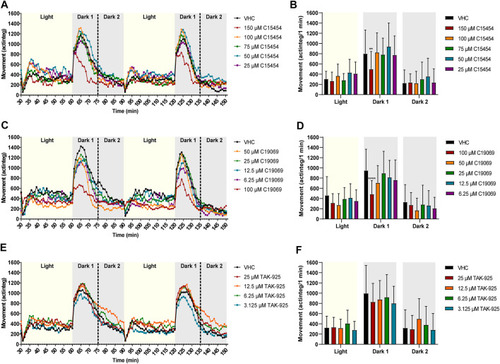- Title
-
Modulation of sleep behavior in zebrafish larvae by pharmacological targeting of the orexin receptor
- Authors
- Pardon, M., Claes, P., Druwé, S., Martini, M., Siekierska, A., Menet, C., de Witte, P.A.M., Copmans, D.
- Source
- Full text @ Front Pharmacol
|
Behavioral analysis of zebrafish larvae. Zebrafish larvae were placed separately in a 96-well plate and incubated with compound or vehicle (VHC, 1% DMSO in embryo medium). After incubation, the 96-well plate was placed in an automated tracking device and larval behavior was recorded for varying times by the Zebralab software. The night assay consisted of a 2 h incubation and habituation period, followed by a 12 h recording period with a 1 h light phase from 8 p.m to 9 p.m., a 10 h dark phase from 9 p.m to 7 a.m., and again a 1 h light phase from 7 a.m to 8 a.m. The dark-light assay consisted of a 2 h 30 min incubation and habituation period, followed by a 2 h recording period with alternating 30 min dark-light triggers during the day. Figure created with |
|
Representative IP-One dose response curves for antagonists EMPA, Suvorexant, SB 674042 and TCS 1102 on human OX2R (purple), zebrafish OX2R (blue) and hOX2R (T111S, I130L, V353I) (green). Antagonists were incubated for 30 min at 37°C and subsequently the cells were stimulated with 1 µM of reference agonist C14917. Cells were incubated for 2 more hours and subsequently readout was performed. Dose responses were performed as technical duplicates, data were normalized to 10 µM of reference agonist C14917. |
|
Representative IP-One dose response curves for agonists TAK-925, C15454 and C19069 on human OX2R (purple), zebrafish OX2R (blue) and hOX2R (T111S, I130L, V353I) (green). Cells were incubated for 1 h with agonist and subsequently readout was performed. Dose responses were performed as technical duplicates, data were normalized to 10 µM of reference agonist C14917. |
|
Behavioral analysis of 6 dpf zebrafish larvae treated with orexin receptor antagonists in the night assay. Locomotor profiles of animals are expressed as mean actinteg units per 10 min treated with suvorexant |
|
Behavioral analysis of 6 dpf zebrafish larvae treated with orexin 2 receptor agonists in the night assay. Locomotor profiles of animals are expressed as mean actinteg units per 10 min treated with C15454 |
|
Behavioral analysis of 6 dpf zebrafish larvae treated with orexin receptor antagonists in the dark-light assay. Locomotor profiles of animals are expressed as mean actinteg units per 1 min treated with suvorexant |
|
Behavioral analysis of 6-dpf zebrafish larvae treated with orexin 2 receptor agonists in the dark-light assay. Locomotor profiles of animals are expressed as mean actinteg units per 1 min treated with C15454 |
|
Location of the three semi-conserved binding site mutations mapped on human OX2R. Figure generated using GPCRdb ( |








